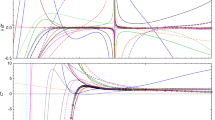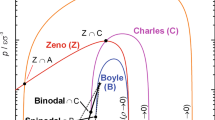Abstract
Dynamic viscosity and density of aqueous KI solutions are measured in a temperature range of 283.15-333.15 K for molar fractions from 0 to 0.07. Specific electrical conductivity of these solutions is measured for molar concentrations from 0.001 mol/L to 0.01 mol/L. The absorption spectra of these solutions in the IR region are derived for molar fractions from 0 to 0.082; the frequency of OH stretchings of the water molecules is determined. Activation parameters of the viscous flow of aqueous KI solutions, partial molar volume of KI in solution, volumetric thermal expansion coefficient of the solution, energy and length of hydrogen bonds between water molecules in the solution, effective radii of K+ and I– ions in water, hydration numbers, and activation parameters of ionic conductivity at the considered temperatures and concentrations are calculated from the experimental data. It is established that the enthalpy of viscous flow activation, entropy of viscous flow activation, and hydrogen bond energy decrease with increasing solution concentration, while the partial KI molar volume, solution′s volumetric thermal expansion coefficient, and hydrogen bond lengths increase. It is also shown that effective radii of K+ and I– ions in water and hydration numbers are reff(K+) = 3.18 Å, reff(I–) = 3.13 Å, Nг(K+) = 11.4, Nг(I–) = 7.6, respectively, while the Gibbs activation energy, enthalpy, and entropy of ionic conduction decrease with increasing temperature.




Similar content being viewed by others
REFERENCES
A. A. Zaitsev and V. N. Afanas′ev. Development of the theory of strong electrolytes considering the concentration dependence of hydration numbers. J. Struct. Chem., 2007, 48(5), 874-881. https://doi.org/10.1007/s10947-007-0130-9
A. Jakubowska and T. Kozik. Chemometric study of kosmotropic and chaotropic ion properties related to Hofmeister effects. J. Chemom., 2019, 33(11). https://doi.org/10.1002/cem.3187
Q. Cao and R. R. Netz. Anomalous electrokinetics at hydrophobic surfaces: Effects of ion specificity and interfacial water structure. Electrochim. Acta, 2018, 259, 1011-1020. https://doi.org/10.1016/j.electacta.2017.11.031
E. A. Masimov, B. G. Pashayev, H. S. Hasanov, and N. H. Hasanov. Viscosimetry and IR spectroscopy studies of the structure of water in aqueous KBr solutions. Russ. J. Phys. Chem. A, 2015, 89(7), 1244-1247. https://doi.org/10.1134/s0036024415070249
R. Zangi and B. J. Berne. Aggregation and dispersion of small hydrophobic particles in aqueous electrolyte solutions. J. Phys. Chem. B, 2006, 110, 22736. https://doi.org/10.1021/jp064475+
M. Kondoh, Y. Ohshima, and M. Tsubouchi. Ion effects on the structure of water studied by terahertz time-domain spectroscopy. Chem. Phys. Lett., 2014, 591, 317-322. https://doi.org/10.1016/j.cplett.2013.11.055
O. G. Telenkova, N. F. Farashchuk, and E. O. Markova. Ispol′zovanie dilatometricheskogo metoda dlya opredeleniya strukturnogo sostoyaniya vody i chisla gidratatsii ionov (Use of the dilatometric method for the determination of the structural state of water and the number of ion hydration). Vestn. Tver. Gos. Univ. Ser.: Khim., 2017, (4), 113-119. [In Russian]
E. A. Masimov, H. Sh. Hasanov, and B. G. Pashayev. Liquid Viscosity. Baku, Azerbaijan: Laman, 2016.
E. Leontidis. Chaotropic salts interacting with soft matter: Beyond the lyotropic series. Curr. Opin. Colloid Interface Sci., 2016, 23, 100-109. https://doi.org/10.1016/j.cocis.2016.06.017
R. Zangi. Can salting-in/salting-out ions be classified as chaotropes/kosmotropes? J. Phys. Chem. B, 2010, 114(1), 643-650. https://doi.org/10.1021/jp909034c
E. A. Masimov, B. G. Pashyaev, and M. R. Rajabov. Determining conformations and sizes of polyethylene glycol macromolecules in water–polyethylene glycol–LiOH systems by the viscometry method. J. Struct. Chem., 2020, 61(6), 880-886. https://doi.org/10.1134/s0022476620060062
V. V. Loskutov and G. N. Kosova. Molecular structure of an ethylene glycol–water solution at 298 K. Russ. J. Phys. Chem. A, 2019, 93(2), 260-264. https://doi.org/10.1134/s003602441902016x
T. Ikeda, M. Boero, and K. Terakura. Hydration of alkali ions from first principles molecular dynamics revisited. J. Chem. Phys., 2007, 126(3), 034501. https://doi.org/10.1063/1.2424710
A. N. Gagarin, M. G. Tokmachev, H. T. Trobov, and N. B. Ferapontov. Effect of ion hydration on the degree of swelling of a crosslinked polyvinyl alcohol gel. Russ. J. Phys. Chem. A, 2020, 94(1), 95-101. https://doi.org/10.1134/s0036024420010069
E. A. Masimov, B. G. Pashayev, and M. R. Rajabov. Viscometric and densimetric study of water–PEG–KBr systems. Russ. J. Phys. Chem. A, 2020, 94(12), 2574-2580. https://doi.org/10.1134/s0036024420120183
C. Krekeler, B. Hess, and L. Delle Site. Density functional study of ion hydration for the alkali metal ions (Li+, Na+, K+) and the halide ions (F−, Br−, Cl−). J. Chem. Phys., 2006, 125(5), 054305. https://doi.org/10.1063/1.2218338
P. Ball and J. E. Hallsworth. Water structure and chaotropicity: their uses, abuses and biological implications. Phys. Chem. Chem. Phys., 2015, 17(13), 8297-8305. https://doi.org/10.1039/c4cp04564e
E. A. Masimov, B. G. Pashayev, and H. S. Hasanov. Viscometric study of diluted aqueous solutions of polyethylene glycols of different molecular weights. Russ. J. Phys. Chem. A, 2019, 93(5), 988-990. https://doi.org/10.1134/s0036024419050224
A. B. Ibrahimli. Dynamic viscosity characteristics of liquid metals. Adv. Phys. Res., 2021, 3(3), 142-146.
B. G. Pashaev and M. R. Rajabov. Viscometric and densiometric investigation of water–polyethylene glycol–KCl, KBr, KI systems. Russ. J. Phys. Chem. A, 2022, 96(10), 2082-2087. https://doi.org/10.1134/s0036024422090254
S. M. Saqib Nadeem. Viscometric study of ionic interactions of MgSO4 in water and water–ethanol mixtures at different temperatures. Russ. J. Phys. Chem. A, 2022, 96(4), 849-859. https://doi.org/10.1134/s0036024422040306
O. E. A. Adam, A. H. Al-Dujaili, and A. M. Awwad. Volumetric properties of aqueous solutions of ethylene glycols in the temperature range of 293.15-318.15 K. ISRN Phys. Chem., 2014, 2014, 1-10. https://doi.org/10.1155/2014/639813
N. N. Medvedev, V. P. Voloshin, A. V. Kim, A. V. Anikeenko, and A. Geiger. Culation of partial molar volume and its components for molecular dynamics models of dilute solutions. J. Struct. Chem., 2013, 54(S2), 271-288. https://doi.org/10.1134/s0022476613080088
E. A. Masimov, B. G. Pashaev, and M. R. Rajabov. Structural properties of water–PEG–LiOH, NaOH, and KOH solutions, according to viscometry and densimetry data. Russ. J. Phys. Chem. A, 2019, 93(12), 2562-2565. https://doi.org/10.1134/s0036024419120197
N. Ouerfelli, Z. Barhoumi, and O. Iulian. Viscosity arrhenius activation energy and derived partial molar properties in 1,4-dioxane+water binary mixtures from 293.15 to 323.15 K. J. Solution Chem., 2012, 41(3), 458-474. https://doi.org/10.1007/s10953-012-9812-9
L. T. Vlaev, M. M. Nikolova, and G. G. Gospodinov. Electrotransport properties of ions in aqueous solutions of H2SeO4 and Na2SeO4. J. Struct. Chem., 2005, 46(4), 633-640. https://doi.org/10.1007/s10947-006-0181-3
E. A. Masimov, B. G. Pashayev, and H. Sh. Hasanov. Activation parameters for electrical conductivity of Li+, Na+, K+, Rb+ and Cs+ ions in water solutions. J. Low-Dimens. Syst., 2018, 2, 32.
V. P. Voloshin and Y. I. Naberukhin. Proper and improper hydrogen bonds in liquid water. J. Struct. Chem., 2016, 57(3), 497-506. https://doi.org/10.1134/s0022476616030112
A. V. Karyakin and G. A. Kriventsova. Sostoyanie vody v organicheskikh i neorganicheskikh soyedineniyakh (State of water in organic and inorganic compounds). Moscow, Russia: Nauka, 1973. [In Russian]
E. A. Masimov, G. S. Khasanov, and B. G. Pashaev. Changes in the structure of water in aqueous solutions of acetic acid, depending on concentration and temperature according to densitometry, viscosimetry, and IR spectroscopy data. Russ. J. Phys. Chem. A, 2013, 87(6), 948-951. https://doi.org/10.1134/s0036024413060186
Vodorodnaya svyaz′: sbornik statei (Hydrogen Bond: a Collection of Articles) / Ed. N.D. Sokolov. Moscow, Russia: Nauka, 1981. [In Russian]
E. A. Masimov, G. S. Khasanov, and B. G. Pashaev. Changes in the structure of water in aqueous solutions of acetic acid, depending on concentration and temperature according to densitometry, viscosimetry, and IR spectroscopy data. Russ. J. Phys. Chem. A, 2013, 87(6), 948-951. https://doi.org/10.1134/s0036024413060186
J. D. Worley and I. M. Klotz. Near-infrared spectra of H2O–D2O solutions. J. Chem. Phys., 1966, 45(8), 2868-2871. https://doi.org/10.1063/1.1728040
A. de Diego. Application of the electrical conductivity of concentrated electrolyte solutions to industrial process control and design: from experimental measurement towards prediction through modelling. Trends Anal. Chem., 2001, 20(2), 65-78. https://doi.org/10.1016/s0165-9936(00)00081-9
P. Atkins and J. De Paula. Physical Chemistry. London, UK: Oxford University Press, 2006.
E. A. Masimov, B. G. Pashayev, M. R. Rajabov, and L. P. Aliyev. Viscozymetric study of aqueous solutions LiOH, NaOH and KOH. In: Modern Trends in Physics: Conf. Proc., Baku, Azerbaijan, May 1-3, 2019. Baku, Azerbaijan: Baku State University, 2019, 196.
S. M. S. Nadeem, R. Saeed, and F. Anbreen. Viscometric study of ionic interactions of Fe2+ ions in water and aqueous sunflower oil emulsions at different temperatures. Russ. J. Phys. Chem. A, 2022, 96(12), 2650-2658. https://doi.org/10.1134/s0036024422120275
E. A. Masimov, B. G. Pashaev, and G. S. Hasanov. Structure of aqueous solutions of sucrose, derived from viscosimetry data and IR spectroscopy. Russ. J. Phys. Chem. A, 2017, 91(4), 667-671. https://doi.org/10.1134/s003602441704015x
Author information
Authors and Affiliations
Corresponding author
Ethics declarations
The author declares that he has no conflicts of interests.
Additional information
Russian Text © The Author(s), 2023, published in Zhurnal Strukturnoi Khimii, 2023, Vol. 64, No. 7, 112762.https://doi.org/10.26902/JSC_id112762
Rights and permissions
About this article
Cite this article
Pashayev, B.G. Studying the Structure of Water in Aqueous KI Solutions Using Viscometry, Densitometry, Conductometry, and IR Spectroscopy. J Struct Chem 64, 1176–1187 (2023). https://doi.org/10.1134/S0022476623070028
Received:
Revised:
Accepted:
Published:
Issue Date:
DOI: https://doi.org/10.1134/S0022476623070028




